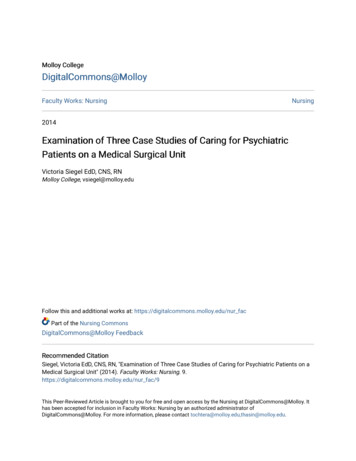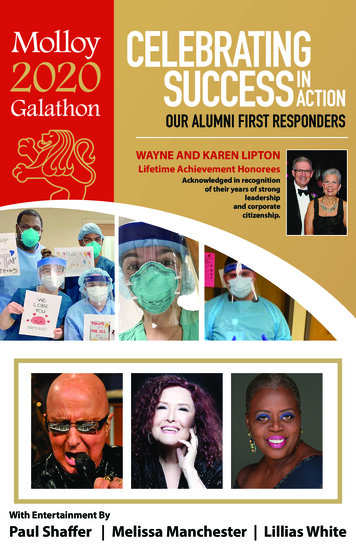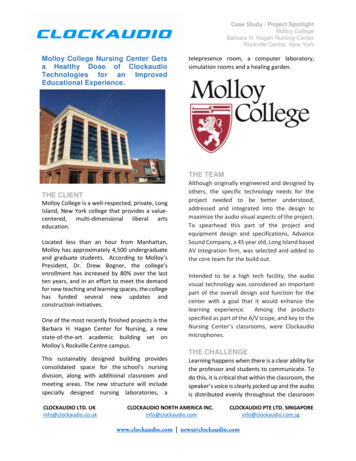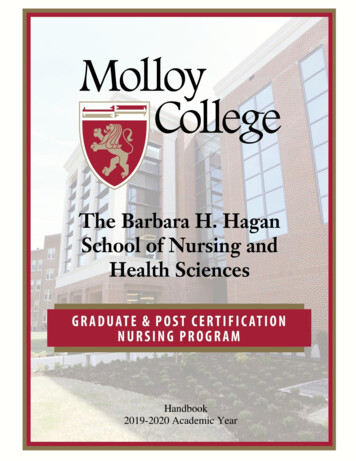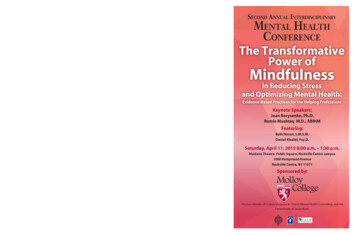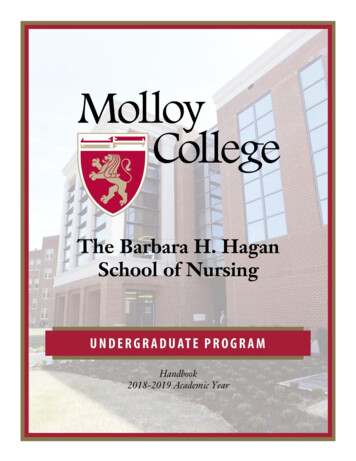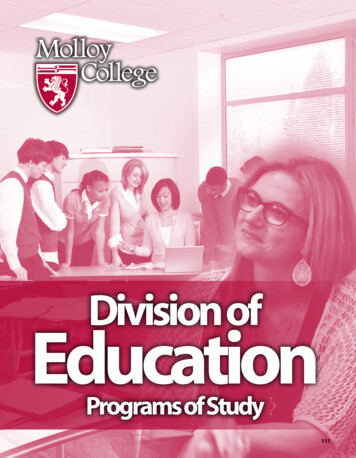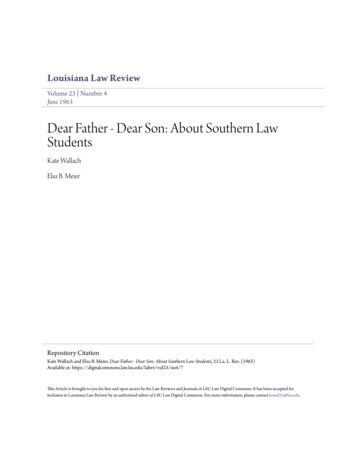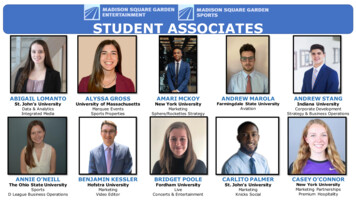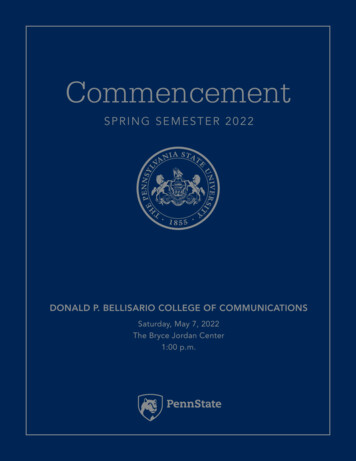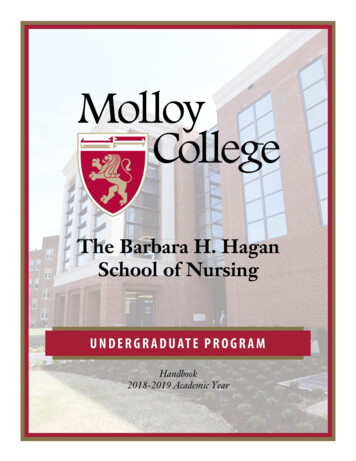
Transcription
Dear Student,Welcome to Molloy College and the Undergraduate Program. I knowthat you have worked hard to achieve your goal of being accepted into abaccalaureate nursing program and that you are excited about theeducational and experiential journey you are about to begin.The undergraduate program at Molloy is widely known for its excellence innursing education. Many of you may know graduates of our program whoare providing nursing care to patients within the community. You arebeginning your own education down that path and will soon join thesenurses as colleagues.The faculty of The Barbara H. Hagan School of Nursing is here to help youachieve your goal of becoming a professional nurse. Always remember toseek their guidance and assistance as you journey down this educationalroad. We are all here to help you, but you need to ask and do your part inmaking that dream come true.Please stop in to say hello and to ask a question if you wish. I look forwardto meeting you during your schooling.SincerelyRose SchecterRose Schecter, PhD, RNProfessorAssociate Dean Undergraduate Program
Heraldic History of the Amorial Seal of Molloy CollegeThe principal partition of the shield displays the blue and silver of the arms of Bavaria,Germany, from whence the Amityville Dominican Sisters immigrated to the United Statesin 1853.The black lion between three red trefoils are from the coat of arms of Archbishop ThomasE. Molloy for whom the College is named.The upper compartment of the shield displays the Dominican cross to indicate the heritageof the College.The crest is composed of a book, the symbol of learning, charged with the alpha and omega,the first and last letters of the Greek alphabet. The book is adorned with a Marian goldencrown. Both the book and crown symbolize the Catholic tradition of the College.
TABLE OF CONTENTSI.THE BARBARA H. HAGAN SCHOOL OF NURSINGA.B.C.D.History.1Philosophy.2Organization .3Committees .3II.UNDERGRADUATE CURRICULUMA.B.C.D.E.F.Statement of Purpose .5Characteristics of the Baccalaureate Graduate .5Humanistic Nursing Framework .6Definitions of Concepts and Sub Concepts of the Humanistic Nursing Framework .7Characteristics of Baccalaureate Graduates and Level Objectives .8Horizontal and Vertical Strands of the Humanistic Nursing Framework .11III.POLICIESA.B.Admission .12Progression Requirements .131.Academic Integrity.132.Reading and Writing Proficiency.133.Mathematics Proficiency .134.Drug Calculation Proficiency .145.Criteria for Progression .156.Testing Program .157.Semester and Summer Course Offerings .168.Liberal Arts Requirements .179.Change of Major .1710.Graduation.17Course and Clinical Policies and Requirements .171.Cardio Pulmonary Resuscitation.172.Fire Safety .183.Child Abuse .184.Transportation .185.Travel Time Between Classes .186.Liability Insurance .187.Clinical Agencies .188.Clinical Hours .18C.
D.E.F.G.H.I.J.K.L.M.N.O.General Course Information .18Grading Criteria .191.Absence Information .192.Non-Clinical Courses .193.Clinical Courses .19Clinical Attendance Policy .22Clinical Failure Policy .23Clinical Withdrawal Policy .24Academic Review Process .25Clinical Injury/Insurance .25Uniforms .30Substance Abuse .29Social Media .29Non-Discrimination in Nursing Practice .30Strike Policy .30IV.HEALTH REQUIREMENTSA.B.C.D.Health Requirements .31Medical Clearance .31Immunization Policy .32Infectious Disease Policy .33V.ACADEMIC RESOURCESA.B.C.Advisement .36Hierarchy of Communication for Academic Problems .36Academic Resources .361.College Academic Resource Center .362.Nursing Lab .363.Academic Enrichment Program .364.Academic Computer Laboratory.365.Libraries .376.Media Center .377.Alumni Lifetime Scholarships .37Network for Assistance with Personal Problems .381.Academic Problems .382.Health Problems .383.Additional Personal Problems.38D.
VI.PROFESSIONAL ORGANIZATIONSA.B.C.D.E.F.G.H.American Association of Colleges of Nursing .39American Nurses Association.39Commission on Collegiate Nursing Education .39National League for Nursing .39National Student Nurses Association.39New York State Nurses Association .39Nurses Association of the Counties of Long Island.40Sigma Theta Tau .40VII.STUDENT INVOLVEMENT AND ORGANIZATIONSA.B.Molloy Nursing Student Association .40Senior Pinning Ceremony Undergraduate Program Schedule and HonorsClinical Practice GuidelinesStandard PrecautionsSection 504: Rehabilitation ActNational Student Nurses’ Association: Code of Academic and Clinical ConductNursing Student Code of Pre-Professional ConductEssential Professional BehaviorsProfessional Behaviors PolicyAcademic Review Process and FormHealth Insurance Portability and Accountability Acknowledgment FormAcademic Progression RequirementsClinical Attendance PolicyClinical Make-Up FormVideo/Photography Release FormState Criteria for LicensureClinical Learning Laboratories Guidelines and Policies
I.A.THE BARBARA H. HAGAN SCHOOL OF NURSING AND HEALTH SCIENCESHistory of Molloy CollegeMolloy Catholic College for Women was established in 1955 by the Sisters of St. Dominic ofAmityville under a provisional charter of the University of the State of New York. This wasaccomplished with the guidance of the Most Reverend Thomas E. Molloy, Archbishop of Brooklyn.The absolute charter was granted in 1960 with the power to confer the degrees of Bachelor of Arts andBachelor of Science.A major in Nursing was introduced in the college in September 1955 with first capping ceremony in1958. The Nursing Program received accreditation by the National League for Nursing (NLN) May1969.In 1971, the name of the college was officially changed to Molloy College. In 1972, through a CharterAmendment, men were permitted matriculation in the Nursing Program and Evening Division. By avote of the Board of Trustees in 1982, men were admitted to all Molloy College programs. MolloyCollege is accredited by the Board of Regents of the University of the State of New York, and theMiddle States Association of Colleges and Schools. At present, Molloy College awards degrees inmore than 30 areas of concentration.The Nursing Program has grown in size and stature over the years and at present, has the largest numberof majors on the college campus. The Degree Completion Program for Registered Nurses wasimplemented in the fall of 1971. In 1988, the college welcomed its first Graduate Students whoenrolled in the program leading to a Master of Science Degree in Nursing. Post-Master’s CertificatePrograms and the Dual Degree Program for Registered Nurses and Second Degree students wereimplemented in 1994. The Nurse Practitioner Programs were initiated in 1995.The last NLN site visit was in October 1992 and the programs (Graduate and Undergraduate Programs)received full accreditation. In 1998 both programs was granted full ten year accreditation by theCommission on Collegiate Nursing Education (CCNE). In January 2004, the interim report to CCNEwas accepted. After the most recent reaccreditation cycle in fall 2018, the nursing programs (BS, MS,DNP and Advanced Certificate) continue to be fully accredited by CCNE.In July 2006, the department became a Division within the College.The Molloy College Nursing Program has an excellent reputation in the professional Nursingcommunity in the New York Metropolitan area & since its inception, there have been thousands ofnursing graduates from the Undergraduate Program.In September 2010, the first doctoral students were accepted. The second doctoral program, Doctor ofNursing Practice (DNP) began in September 2014. The Division moved into The Barbara H. HaganCenter for Nursing on January 19, 2016 and in April of that year officially changed its name to TheBarbara H. Hagan School of Nursing. The dedication ceremony was held on the lawn in front of thebuilding on April 19th with community leaders, religious leaders, faculty, students and collegeleadership in attendance. This auspicious school year ended with a graduation ceremony with 10 PhDstudents being hooded by faculty and the president. In September 2019, as the school expanded toinclude the departments of Communication Sciences and Disorders and Allied Health Sciences, it wasrenamed The Barbara H. Hagan School of Nursing and Health Sciences.1
B.PhilosophyThe faculty of the School of Nursing, in accord with Molloy College, believes that every personas a biological, psychological, sociological, spiritual cultural being has an innate potential for selfactualization in a dynamic universe. We believe that human beings are entitled to an environmentwhich fosters individual self-esteem and mutual positive regard. We hold in high esteem theinherent worth and dignity of all individuals. It is the concept of valuing, in relation to humanityenvironment-health, which gives meaning to humanistic nursing practice.Each human being is an integrated whole, evolving through time. The uniqueness of humanity isreflected through individuals, families, and communities continuously interacting with theirenvironment. Since environment influences the health and well-being of humanity, we recognizeour collective responsibility to strive toward an environmentally better world.Health is a dynamic state of bio-psycho-socio-spiritual-cultural well-being. A responsible societyprovides a health care system that enables individuals to function at their highest level. Nursingmeets the actual and potential needs of humanity by assisting a diverse, multi-cultural populationto attain, maintain, and retain optimum health.Nursing is both a science and an art, which focuses on the diagnosis and treatment of humanresponses. Humanistic nursing integrates theory and practice within a framework of ethicaldecision-making. Nursing provides health care for individuals, families, and communities.Central to professional practice are caring, interpersonal communication, and nursing therapeutics.We believe that nursing has a social contract grounded in the professions code of ethics andrequires a lifelong professional commitment.Baccalaureate nursing education is based on liberal arts and sciences. This foundationdistinguishes baccalaureate nurses by preparing them to communicate, evaluate, and providehumanistic health care. Professional nursing education includes a scientific body of knowledge,which is augmented by the findings of multi-disciplinary research. Baccalaureate educationprepares the nurse generalist in a beginning leadership role as a member of an interdisciplinaryhealth care team who is able to practice in a variety of settings.The faculty believes that learning is an ongoing process that fosters intellectual inquisitiveness,critical thinking and decision-making, a creative approach to life situations, and an appreciation ofethical and aesthetic values. We believe learning occurs best in a humanistic environment thatvalues students and supports them in becoming increasingly self aware and self-directed.Updated June 2007Approved September 20072
C.OrganizationUndergraduate ProgramsIn addition to a generic baccalaureate program, specific programs are available for RNBaccalaureate Degree Completion, and for Second Degree Students.Qualified students with previous degrees, transfer students and students who have completedthe majority of their liberal arts requirements who meet specific criteria may accelerate inthe program.Graduate ProgramsFive tracks are offered in the Master of Science Degree Program in Nursing. Studentschoose from clinical concentrations in the areas of Adult-Gerontology Primary Care NursePractitioner, Pediatric Nurse Practitioner, Family Nurse Practitioner, Family PsychiatricMental Health Nurse Practitioner, Nursing Education, Nursing Administration withInformatics and Clinical Nurse Specialist Adult-Gerontology Health.The minimumnumber of credits required for graduation from the Master’s Program is 43.Doctoral ProgramsThe PhD program was initiated in the fall 2010 with 10 doctoral students. The program ofstudy will prepare nurses for leadership roles in academia, health policy formulation,healthcare administration and clinical practice. This is the first doctoral program at theCollege. The DNP program began in September 2014, and also takes in a cohort each fall.D.CommitteesUndergraduate Programs Committee. The purpose of this committee is to plan, develop,monitor and evaluate all matters related to the Undergraduate programs. Issues may bereferred to the committee by the Dean, Associate Dean/Director or recommendation of thefaculty and/or students.Graduate Committee. The purpose of this committee is to plan, develop, monitor andevaluate all matters related to the Graduate Program. Issues may be referred to thecommittee by the Dean, Associate Dean/Director or recommendation of the faculty and/orstudents.Doctoral PhD Committee. The purpose of this committee is to plan, develop, monitor andevaluate all matters related to the Doctoral Program. Issues may be referred to thecommittee by the Dean, Associate Dean/Director or recommendation of the faculty and/orstudents.3
Doctoral DNP Committee. The purpose of this committee is to plan, develop, monitorand evaluate all matters related to the Doctoral Program. Issues may be referred to thecommittee by the Dean, Associate Dean/Director or recommendation of the faculty and/orstudents.4
II.A.UNDERGRADUATE CURRICULUMStatement of PurposeThe purpose of the Baccalaureate Program in Nursing at Molloy College is to prepare thenurse generalist to practice in a variety of settings. The Judeo-Christian tradition of MolloyCollege provides the foundation for humanistic professional practice.B.Characteristics of the Baccalaureate GraduateThe graduate of the baccalaureate nursing program of Molloy College is a liberally educatedindividual who has acquired the knowledge and skills to provide humanistic nursing practicein multiple settings as well as a foundation for advanced study in nursing. This nurse:1.Demonstrates professional practice that upholds the inherent worth and dignity ofindividuals, families and communities, sensitive to their diverse spiritual and culturalneeds.2.Synthesizes knowledge from the humanities, sciences and nursing as the foundationfor critical thinking and decision making.3.Employs effective communication skills throughout the scope of professionalpractice.4.Utilizes evolving technology to promote quality patient outcomes.5.Provides consistent, safe and competent patient centered care.6.Considers the complex economic, legal, political and ethical issues affecting thedelivery of care in the global and dynamic health care environment.7.Assumes responsibility and accountability for professional nursing practice.8.Demonstrates beginning leadership abilities as a member of an interdisciplinaryhealth care team.9.Evaluates and integrates research that supports evidenced based nursing practice.10.Demonstrates intellectual inquisitiveness and a lifelong commitment to learning.Updated June 2007Approved September 20075
c Nursing Framework.The Molloy Humanistic Nursing Framework affirms nursing’s human foundations and isprimarily concerned with human beings, their values, beliefs, perceptions, capacities andachievements. The humanistic framework addresses nursing as its central concept.Integral to Nursing are Humanity, Environment, Health, and Valuing. Nursing interactswith each of these four concepts as they in turn, interact with each other. These conceptsare addressed throughout the program.The sub-concepts of Nursing are knowledge, responsibility and accountability,leadership/management, research, and professional role. These sub-concepts are introducedat Level I and are further developed within each subsequent level.6
D.Definitions of the Concepts and Sub-Concepts of the Humanistic NursingFrameworkConceptsHUMANITYDefinitionsA Unique human being, functioning as an integrated whole,reflecting bio-psycho-socio-spiritual-cultural dimensions.ENVIRONMENTThe sum total of all internal and external dimensions thatinfluence human beings.HEALTHA dynamic state of bio-psycho-socio-spiritual cultural wellbeing.VALUINGTo hold in high esteem the inherent worth and dignity of allindividuals.NURSINGA science and an art which focuses on the diagnosis and treatmentof human responses.DefinitionsNursing knowledge is based on the liberal arts and sciences andincorporates humanity/environment /ACCOUNTABILITYProfessional nurses accept responsibility and are therefore heldaccountable to maintain Standards of Practice and adhere to theCode of Ethics of the profession.LEADERSHIP/MANAGEMENTWorking collaboratively with individuals and groups toaccomplish professional goals.RESEARCHA process of inquiry that provides evidence contributing tonursing’s expanding body of knowledge.PROFESSIONALROLEProvides humanistic health care to promote health and manageillness for individuals, families and communities in accordancewith standards of nursing practice.Updated June 2007Approved September 20077
E.1.4Characteristics of the Baccalaureate Graduate and Level ObjectivesCHARACTERISTICSDemonstrates professional practice that 1.1upholds the inherent worth and dignity ofindividuals, families, and communities,sensitive to their diverse spiritual and 1.2cultural needs.1.32.4Synthesizesknowledgefromthe 2.1humanities, sciences and nursing as thefoundation for critical thinking and decisionmaking.2.22.33.44.4Employs effective communication skills 3.1throughout the scope of professionalpractice.3.2LEVEL OBJECTIVESDefines concepts of spiritual andcultural valuing of self and others.Discusses diverse spiritual andcultural value systems in relationto individuals, families and communities.Integrates knowledge of diverse spiritualand cultural value systems in theprovision of nursing care to individuals, families acommunities.Acquires knowledge from the humanities,sciences and nursing building a foundation forcritical thinking and decision making.Demonstrates integration of knowledge from thehumanities, sciences and nursing as thefoundation for critical thinking and decisionmaking in nursing practice.Applies increasing knowledge from thehumanities, sciences, and nursing as thefoundation for critical thinking and decisionmaking in nursing practice.Defines communication skills that can be used inprofessional practice.Examines varied communication skills to use inselected professional practice situations.3.3Differentiates varied communication techniquesappropriate in varied professional practicesituations.Utilizes evolving technology to promote 4.1quality patient outcomes.Identifies the range of technologies that facilitateclinical care.4.2Develops a repertoire of skills to effectively usetechnology in the scope of nursing practice.4.3Integrates use of technology in the planning,provision, and documentation of safe, competentnursing care of individuals, families, andcommunities in a variety of health care settings.8
5.46.47.4Provides consistent, safe and competent 5.1patient centered care.Identifies safe practice regulations, goals andstandards to promote competent patient centeredcare5.2Demonstrates an understanding of safe practiceregulations, goals and standards relevant to theprovision of competent patient centered care inselected health care environments.5.3Integrates safe practice regulations, goals andstandards in order to provide competent patientcentered care.Considers the complex economic, legal, 6.1political and ethical issues affecting thedelivery of care in the dynamic and globalhealth care environment.6.2Acquires information regarding economic, legal,political, and ethical issues that can affect thehealth care environment6.3Examines the interplay of economic, legal,political, and ethical issues affecting the deliveryof care in selected health care environments.Assumes responsibility and accountability 7.1for professional nursing practice.Discusses responsibility and accountability ascomponents of professional nursing practice.7.2Demonstrates responsibility and accountabilityin planning and providing nursing care inselected practice situations.7.3Demonstrates responsibility and accountabilityin planning and providing nursing care in avariety of practice situations.9Explains specific economic, legal, political, andethical issues that can affect the delivery of carein the health care environment.
8.4Demonstrates beginning leadershipabilities as a member of aninterdisciplinary health care team.8.1Discusses concepts of leadership and theinterdisciplinary health care team as componentsof professional nursing practice.8.2Develops beginning leadership skills whileproviding professional nursing care forindividuals in selected health care settings as amember of the interdisciplinary health care team.8.39.4Evaluates and integrates research that 9.1supports evidence based nursing practice.9.29.310.4Integrates beginning leadership skills as amember of an interdisciplinary team whileproviding professional nursing care for selectedindividuals, families, and communities.Defines the components of researchDiscusses the significance of research forprofessional nursing.Applies knowledge of research to professionalnursing care of individuals, families, andcommunities.Demonstrates intellectual inquisitiveness 10.1and a lifelong commitment to learning.Identifies own learning style and needs andrecognizes the professional obligation to lifelonglearning.10.2Applies knowledge of learning styles and needsto professional growth and development.10.3Develops a strategy for self-enrichment andprofessional growth.Updated July 2007Approved September 200710
Master’sGraduateGeneratesPromotesModelsConducts essionalRoleB.S. GraduateLevel IIILevel IILevel HUMANITYThe Molloy College School of Nursing Humanistic Framework, Extended to the Doctoral Level
III. POLICIESA. AdmissionRequirements: Students are admitted to the nursing program, if they qualify and declare nursing as a major,upon acceptance to Molloy. Admission/transfer requirements are noted in the MolloyCollege catalog.ADMISSION SCREENING EXAMSBARBARA H. HAGAN SCHOOL OF NURSINGFreshman Nursing StudentsThe admission submission of SAT scores will be used for freshmen nursing students to screen formath competency and reading comprehension competency, based on our analysis of therelationships among the math SAT, success on Molloy’s math/arithmetic screening test, andsuccessful completion of the math remediation course. No addition testing of math or reading skillswill be done, as the scores from the SAT will be used to determine need for reading and mathremediation PRIOR to beginning both nursing and science courses.The SAT Scores for Freshman Nursing students are acceptable for consideration if takenwithin one year of high school graduation. Otherwise students are considered transferstudents and will need to take the TEAS as outlined above.Math SAT Score used as screen for math competencies required for success in thenursing major Minimum requirement 540 (no remediation)Students with less than 540 are required to enroll in and successfully pass Math 0600with a grade of P. The course must be passed on the first time it is taken. If a studentdoes not pass Math 0600 he/she cannot progress into the nursing programSAT Reading Test (EBRW subscore) Minimum requirement of 26 or higher (no remediation)Score of 25requiresEnglish 1010 with a minimum grade of C or betterBelow 25requiresEnglish 0900 with a minimum grade of C or better(Molloy College Cata
The Molloy College Nursing Program has an excellent reputation in the professional Nursing community in the New York Metropolitan area & since its inception, there have been thousands of nursing graduates from the Undergraduate Program. In September 2010, the first doctoral students were accepted. .
